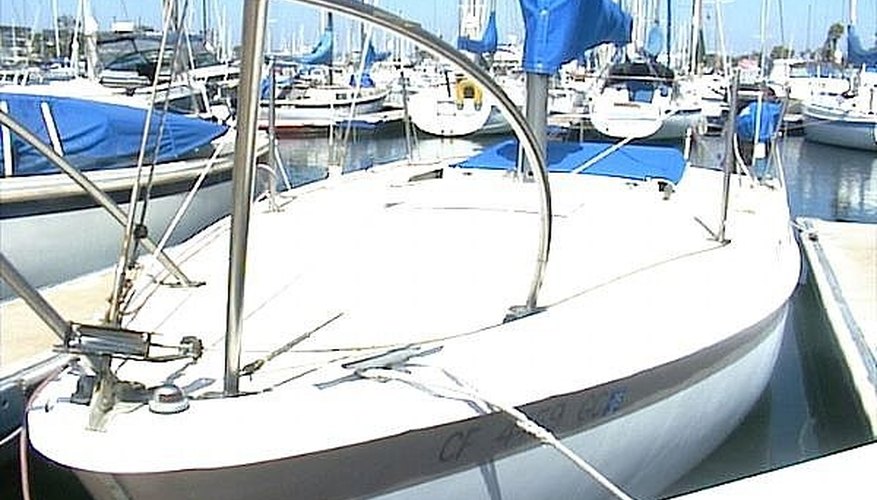
The days of "wooden ships and iron men" are long in the past, but most recreational boats still have enough wood within their construction to serve as a home for termites. Even fiberglass boats make extensive structural use of plywood inside the hull, and deck hatches, cabinetry and furniture can all host termite colonies. Killing termites on a boat is no small job: There are plenty of consumer products that may help, but sometimes you'll need a professional exterminator's assistance.
Identifying the Pest
The termites that invade homes are subterranean termites. They're not normally an issue on boats because they live underground, and boats are seldom in contact with the ground for long enough to be invaded. The usual culprits on a boat are drywood termites, which grow wings during swarming season and can arrive on your boat like any other flying insect. They shed their wings when they find a suitable habitat, so finding pairs of wings on your deck or in odd corners of your cabinetry is a definite warning sign. Mounds of what appear to be sawdust appearing spontaneously on your boat give you another clear alert. That's termite feces, or "frass," and you'll usually see small holes in the wood where it's expelled.
Estimating the Extent of the Problem
Drywood termites spend most of their lives tunneling within the wood, and it can take years before you detect evidence of the colony. Once you've found your first pile of frass, inspect the boat diligently for more. You might have one localized colony, or the pests may have spread throughout your boat – and that, in turn, determines how much effort you'll need to put into getting rid of them.
Your DIY Treatment Options
There are several potential methods you can use to rid your boat of these pests. A few include:
- Simple Removal: If you're very lucky and the infestation is confined to a small, readily accessible portion of a bulkhead, deck or cabinet, you might be able to simply remove and replace the affected piece of wood or plywood. This is only an option for nonstructural woodwork; otherwise, you might fatally damage your boat. There's also the risk that you won't remove the entire colony, or that you have other colonies that aren't yet detectable.
-
Spray-In Termicides: For limited infestations, another option is to spray termicide directly into the colony through the holes the termites use for pushing out frass. These termicides come with a thin straw you'll insert through the hole –
you might need to enlarge it with a drill –
and then spray until the foam fills the tunnel and begins to come out through one of the holes.
Termicide Foggers: Boats are relatively small, enclosed spaces, which means foggers can sometimes be effective. Remove any absorbent materials, such as bedding or cushions, and seal with plastic and tape to make it airtight. Activate the fogger and beat a retreat, leaving the fogger to do its work as directed by the manufacturer's instructions.
Termicide Baits: Baits provide a less intrusive option. They usually pair a termite-friendly food with a potent termicide, which is taken back to the nest and eventually destroys the colony. A great virtue of bait traps is that you can continue to use your boat normally while they do their work.
* Heat Treatment: Bringing the boat to an internal temperature of 120 degrees Fahrenheit for at least 33 minutes can also kill the colony through heat. This can be difficult to do on the water except in very hot climates, but if you have a suitable boat shed you may be able to try it on land with hot-air blowers and space heaters. Don't leave the boat unattended, because of the fire risk.
A Few Words of Caution
Termicides can be harmful if they're used carelessly. If you're working with a termicide spray, make sure the area is well ventilated and follow the manufacturer's safety instructions. At a minimum, you should wear gloves and safety eye wear, and if you're treating multiple nests it's a good idea to come topside for fresh air between applications. With a fogger product, remove the plastic after the allotted time, and open the hatches and portholes to ventilate the interior for a few hours before you return to the boat.
Turning to a Professional
The University of California's Integrated Pest Management Program notes that all of these options share one common characteristic: Their results are highly variable, and they aren't always effective. If you've tried one or more DIY options without lasting success, it may be time to turn to a professional. Professional exterminators have access to more potent termicides, which are capable of penetrating to even concealed colonies. They'll "tent" your boat just the same way they do with houses, either on the water or while it's hauled out. Seek out several quotes, because prices can vary pretty widely. You should also ask about the company's policy on followup service, in case the first treatment isn't fully effective or as a seasonal preventive measure against new infestations.
References
Writer Bio
Fred Decker is a trained chef and prolific freelance writer. He grew up in rural Nova Scotia, and had learned to skin a rabbit with his pocketknife by the age of seven (whenever the pocketknife wasn't lost). He was educated at Memorial University of Newfoundland and the Northern Alberta Institute of Technology, and seldom loses a pocketknife anymore. You'll find his articles on game, foraged foods and other outdoor topics at major sites including eHow, Leaf.TV, Livestrong, OurEverydayLife and many others.



